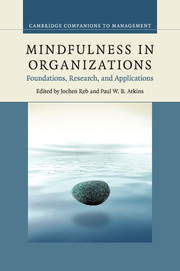Book contents
- Frontmatter
- Contents
- List of figures
- List of tables
- List of contributors
- Foreword
- Preface
- Part I Foundations
- Part II Research
- 6 Mindfulness, identity and work: mindfulness training creates a more flexible sense of self
- 7 Improving decision making through mindfulness
- 8 Mindfulness and creativity in the workplace
- 9 How being mindful impacts individuals' work-family balance, conflict, and enrichment: a review of existing evidence, mechanisms and future directions
- 10 Building and maintaining better leadership relationships through mindfulness
- 11 Leading with mindfulness: exploring the relation of mindfulness with leadership behaviors, styles, and development
- 12 Mindfulness in interpersonal negotiations: delineating the concept of mindfulness and proposing a mindful, relational self-regulation (MRSR) model
- 13 Drawing the line: sketching out the role of visual templates in individual mindfulness and mindful organizing
- Part III Applications
- Index
- References
6 - Mindfulness, identity and work: mindfulness training creates a more flexible sense of self
from Part II - Research
Published online by Cambridge University Press: 05 July 2015
- Frontmatter
- Contents
- List of figures
- List of tables
- List of contributors
- Foreword
- Preface
- Part I Foundations
- Part II Research
- 6 Mindfulness, identity and work: mindfulness training creates a more flexible sense of self
- 7 Improving decision making through mindfulness
- 8 Mindfulness and creativity in the workplace
- 9 How being mindful impacts individuals' work-family balance, conflict, and enrichment: a review of existing evidence, mechanisms and future directions
- 10 Building and maintaining better leadership relationships through mindfulness
- 11 Leading with mindfulness: exploring the relation of mindfulness with leadership behaviors, styles, and development
- 12 Mindfulness in interpersonal negotiations: delineating the concept of mindfulness and proposing a mindful, relational self-regulation (MRSR) model
- 13 Drawing the line: sketching out the role of visual templates in individual mindfulness and mindful organizing
- Part III Applications
- Index
- References
Summary
Introduction
In this chapter we explore the effects of mindfulness training upon individual identity. We aim to show that mindfulness training extends beyond improving emotional self-regulation. Our work shows that over time it changes how we respond to the questions ‘Who am I?’ and ‘Am I really separate from you?’ In turn, these changes have profound implications for wellbeing, effectiveness and relationships at work. Our identity shapes both our individual and relational responding. In this sense, identity underpins many other aspects of organisational behaviour. Indeed, it has been argued that identity has become central to organisational studies and the social sciences more broadly (Alvesson, Ashcraft, and Thomas 2008). In recent years, identity has been linked to issues as diverse as change management (Beech et al. 2011), leadership development (Carroll and Levy 2010; DeRue and Ashford 2010; Hannah, Woolfolk, and Lord 2009), motivation (Osborne and Jones 2011), career development (Petriglieri and Petriglieri 2010), and emotions at work (Atkins and Parker 2012).
In this chapter we explore theoretically and empirically how mindfulness training affects identity and thereby affects work-related outcomes and wellbeing. We adopt the view that mindfulness involves the four processes of: knowing oneself as the observer of experience; flexibly attending to the present moment; willingly accepting experience as it is without trying to change its frequency or intensity, and defusion from the literality of verbal cognitions (Hayes, Strosahl, and Wilson 2011). This approach is based on a contextual-behavioural account of language and human cognition where identity is understood to be the ongoing behaviour of constructing descriptions of one's own behaviours and characteristics (Hayes, Barnes-Holmes, and Roche 2001). When mindful, such personal descriptions are not held as literal truths but rather are held flexibly as passing verbal constructs. We are particularly interested in the shift from treating self-referential statements as literal truths to flexibly engaging with them as constructs that serve varying degrees of usefulness.
- Type
- Chapter
- Information
- Mindfulness in OrganizationsFoundations, Research, and Applications, pp. 133 - 162Publisher: Cambridge University PressPrint publication year: 2015
References
- 6
- Cited by



